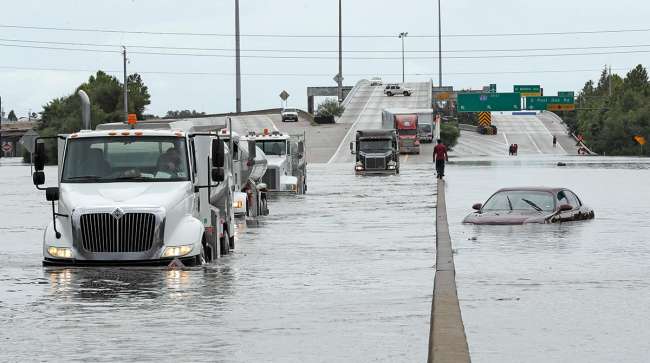Hurricanes to Increase Contract, Spot Rates Outside Disaster Areas

Truckload rates have skyrocketed after hurricanes Harvey and Irma battered Texas and Florida, but the higher prices will also trickle down into states nowhere near the devastation, industry executives say.
John Larkin, an industry analyst at Stifel, Nicolaus & Co., said on a Sept. 7 conference call that the hurricanes will accelerate pricing ahead of the electronic-logging device mandate in December. Truckload carriers would welcome the boost after accepting flat year-over-year rates during the bid season.
“When spot market pricing skyrockets it makes shippers nervous about being able to supplement contract capacity with spot market capacity. They then offer contract price increases to carriers to lock in the capacity, knowing they cannot buy capacity in the spot market on the cheap,” Larkin said.
Eric Fuller, CEO of U.S. Xpress Enterprises, told Transport Topics that conversations between shippers and carriers are currently underway.
“Shippers will say, ‘If you accept 90% of the freight that I’m tendering to you, then I’m willing to pay a certain percentage more in rates in order to ensure that I’m going to have that capacity,’” he said.
The Chattanooga, Tenn. company, which ranks No. 21 on the Transport Topics Top 100 list of the largest for-hire carriers in North America, committed as many as 250 trucks to disaster-related freight, shrinking the capacity to service other customers.
Fleets and owner-operators with leftover capacity can carefully choose the loads to haul, rather than chase any freight available.
“All the trucking companies keep a drawer of folks we felt were abusive through the bid cycle. Customers who weren’t predatory on rate reductions, those are the ones who we will protect capacity-wise in the tightened market,” Fuller said. “The bad actors are the ones who’ll go further down their list to find a truck. Those guys will see the rates go up the most because they’ll struggle to find capacity.”
Epes Carriers Inc., No. 81 on the for-hire TT100, also will distinguish between the top and bottom customers when allocating trucks in the coming weeks.
“We are taking care of our contract year-round customers [non-dedicated] first, but are also seeking out spot opportunities with existing customers where we can provide additional capacity to them at a surge price. This will be taking away capacity from our customers that are slow to pay or are always trying to lower rates [on us],” Epes President Britt Colley said.
For shippers, they’ll have to adjust to the new reality after benefiting from excess capacity in 2016.
“I would advise shippers to advance their tendering time. There’s a difference between needing a truck in four days versus two days. Second, scour the network to find a carrier with a footprint that’s compatible with the freight you need to move,” said Mike Regan, co-founder of TranzAct Technologies, a consultancy firm for shippers.
In the spot market, as owner-operators and fleets shift from their normal lanes to Texas and Florida, truck availability diminishes elsewhere, tipping the supply and demand curve away from shippers, analysts say.
Dan Ryan, vice president at C.H. Robinson, said that the company is closely monitoring the situation because the hurricanes will reduce capacity in unrelated lanes. C.H. Robinson ranks No. 5 on the Transport Topics Top 50 list of largest logistics companies in North America.
DAT data showed a surge in spot demand in Baltimore, Philadelphia and Wilmington, Del., where steamship lines would divert containerships when Irma shut down ports in the Southeast. There was also a 85-cent increase week-over-week in the spot market rate between Chicago and Buffalo to $3.30 per mile for the week ending Sept. 10. It was $2.49 per mile at this time in 2016.
“What does this have to do with Harvey or Irma? On the face of it, nothing. But when you look deeper, you’ll see a chain reaction in the supply chain. This was just the particular lane that truckers found unattractive, but the freight still needed to move,” said Mark Montague, DAT industry pricing analyst.
If the Federal Emergency Management Agency or other shippers tie up equipment, then there is an additional domino effect. Although drivers receive a daily layover fee, the tractor and the trailer remain out of service, sometimes for several days or weeks.
“It’s not a drop-and-hook situation in most cases, so there is a ripple effect in the market. Based on history, the turn down rate will go up eight to 10 percentage points,” said Stephen Silverman, chief operating officer at Raven Transport, which is based in Jacksonville, Fla.
The dry van carrier survived Hurricane Irma unscathed despite record flooding in Jacksonville. However, floodwaters in the parking lot at the city’s Maxwell House manufacturing plant left dedicated trailers from Raven Transport and other carriers in several feet of water around the cross dock.



